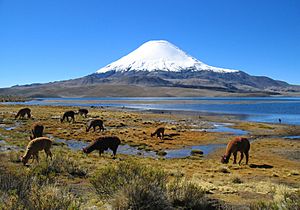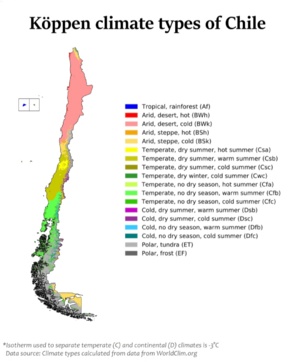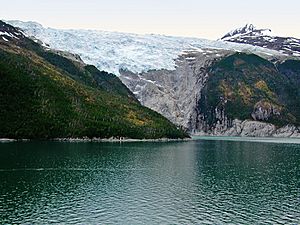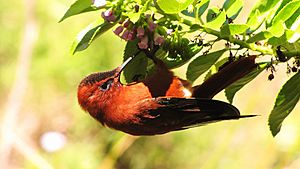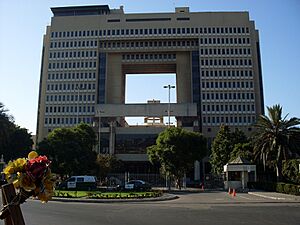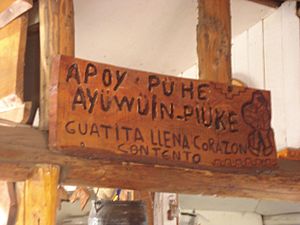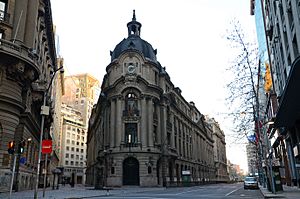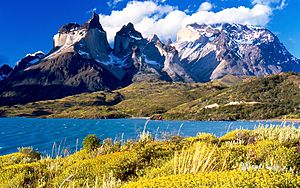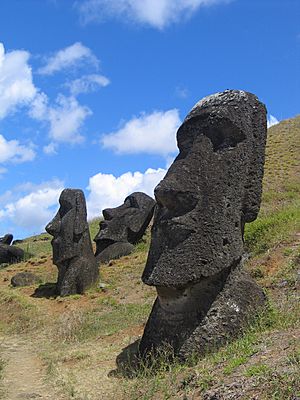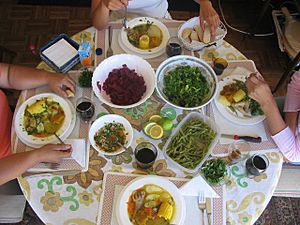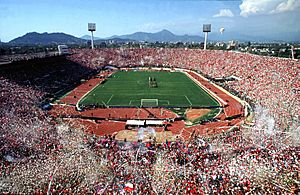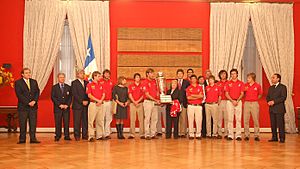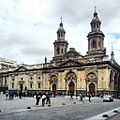Chile facts for kids
Quick facts for kids
Republic of Chile
|
|
|---|---|
|
Motto: Por la razón o la fuerza
("By reason or by force") |
|
|
Anthem: Himno Nacional de Chile
("National Anthem of Chile") |
|
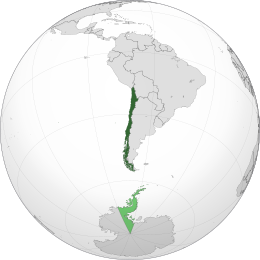
Chilean territory in dark green; claimed but uncontrolled territory in light green
|
|
| Capital and largest city
|
Santiagoa 33°26′S 70°40′W / 33.433°S 70.667°W |
| National language | Spanish |
| Religion
(2021)
|
|
| Demonym(s) | |
| Government | Unitary presidential republic |
| Gabriel Boric | |
| José García Ruminot | |
| Karol Cariola | |
| Legislature | National Congress |
| Senate | |
| Chamber of Deputies | |
| Independence
from Spain
|
|
| 18 September 1810 | |
|
• Declared
|
12 February 1818 |
|
• Recognized
|
25 April 1844 |
| 11 March 1981 | |
| Area | |
|
• Total
|
756,101.96 km2 (291,932.60 sq mi)b (37th) |
|
• Water (%)
|
2.1 (as of 2015) |
| Population | |
|
• 2023 estimate
|
19,629,588 (63rd) |
|
• Density
|
24/km2 (62.2/sq mi) (198th) |
| GDP (PPP) | 2023 estimate |
|
• Total
|
|
|
• Per capita
|
|
| GDP (nominal) | 2023 estimate |
|
• Total
|
|
|
• Per capita
|
|
| Gini (2021) | ▲ 46 high |
| HDI (2022) | very high · 44th |
| Currency | Chilean peso (CLP) |
| Time zone | UTC−4 and −6 (CLT and EAST) |
|
• Summer (DST)
|
UTC-3 and −5 |
| April to September | |
| Calling code | +56 |
| ISO 3166 code | CL |
| Internet TLD | .cl |
|
|
Chile (officially called the Republic of Chile) is a long, narrow country in South America. It stretches along the southwestern coast. Most people in Chile speak Spanish.
Chile is one of the longest countries on Earth. It claims a part of the Antarctic continent. In the north, you'll find the Atacama Desert, which is the driest place in the world. It gets less than 0.05 mm of rain each year. The central part of Chile, where Santiago and Valparaíso are, has a Mediterranean climate. Temperatures average 28 °C in January and 11 °C in July. This middle area is very fertile.
In 2009, about 16.9 million people lived in Chile. Around 10 million of them live in the central region, near Valparaíso and Santiago. This area makes up only about 20% of the country's total land.
Chile is known for its good education system. Only about 2.7% of people cannot read or write. Many believe Chile has one of the best school systems in South America.
About 95% of Chileans are of European background, including some with Arab roots. Many have a mix of European descent, mostly from Spanish, Basque, Italian, and German ancestors. About 2% of the population are Native American. Another 2% are European immigrants, and about 1% have Asian heritage. Most people are Roman Catholic (62.8%). About 10% are Protestant, and there are also some Jews. The official language is Spanish. Interestingly, Chili peppers, which sound similar to Chile, did not come from this country.
Chile's money is called the Chilean peso.
Chile's rich cultural heritage includes many traditions and events. These are things like visual arts, crafts, dances, holidays, and music. It also has many important buildings, objects, and historical sites. Some of these are recognized as World Heritage Sites by UNESCO. These include the Rapa Nui National Park (1995), the Churches of Chiloé (2000), the historic port city of Valparaíso (2003), Humberstone and Santa Laura Saltpeter Works (2005), and the mining city of Sewell (2006).
Contents
History of Chile
Early Human Settlements
Evidence shows that humans lived in the Monte Verde valley area as far back as 18,500 years ago. Around 10,000 years ago, Indigenous Peoples settled in the fertile valleys and coastal areas of what is now Chile. Early sites include Monte Verde, Cueva del Milodón, and the Pali-Aike Crater.
Inca and Spanish Rule
The Inca Empire briefly expanded into northern Chile. However, the Mapuche people successfully fought off many Inca attempts to control them. The Incas' conquest of Chile ended at the Maule River after a major battle.
In the mid-16th century, Spain conquered and colonized the region. They took over from Inca rule. But the Spanish could not conquer the independent Mapuche people in south-central Chile. This led to the Arauco War.
Independence and Growth
Chile declared its independence from Spain in 1818. By the 1830s, it became a stable republic. In the 19th century, Chile grew a lot economically and in size. The Occupation of Araucanía in the 1880s ended Mapuche resistance. Chile also gained its current northern territory in the War of the Pacific (1879–83). They won this war against Peru and Bolivia.
Modern Chile
In the 20th century, Chile's population grew quickly. In 1973, the elected president Salvador Allende was overthrown in a military coup. A 16-year military government followed, led by Augusto Pinochet. This period resulted in many deaths and disappearances. The military rule ended in 1990 after a vote in 1988. A new democratic government then took over.
Geography of Chile
Chile shares borders with Peru to the north, Bolivia to the northeast, and Argentina to the east. To the far south is the Drake Passage. Chile is very long, stretching over 4,630 kilometers (2,880 miles) from north to south. But it is quite narrow, only about 430 kilometers (265 miles) at its widest point.
The northern Atacama Desert is rich in minerals like copper and nitrates. Chile is the world's largest producer of copper. The Andes Mountains run along Chile's eastern border.
Chile also controls Easter Island and Sala y Gómez Island. These are the easternmost islands of Polynesia.
Chile's Climate
Chile has a very diverse climate. It ranges from the world's driest desert in the north (the Atacama Desert) to a Mediterranean climate in the center. Easter Island has a tropical climate, and the south has an oceanic climate with glaciers. Chile experiences four seasons: summer (December to February), autumn (March to May), winter (June to August), and spring (September to November).
Because of its shape, Chile has many rivers, but they are usually short and don't carry a lot of water. Most flow from the Andes to the Pacific Ocean. In the dry north, the Loa River is the longest, at 440 kilometers. In the central-north, rivers like the Aconcagua and Maipo create important farming valleys.
Climate change is expected to affect Chile, possibly leading to more wildfires, floods, droughts, and rising sea levels.
Nature and Wildlife
Animals of Chile
Chile is home to some unique South American animals. Larger mammals include the puma (also called cougar), the llama-like guanaco, and the fox-like chilla. In the forests, you can find different types of marsupials and a small deer called the pudu.
There are many kinds of small birds. Few freshwater fish are native to Chile. However, North American trout have been successfully brought into the Andean lakes. The ocean waters near Chile are full of fish and marine life due to the Humboldt Current. This supports many seabirds, including several types of penguins. Many whales and six species of seals also live in the area.
Fungi in Chile
Over 3,000 species of fungi have been recorded in Chile. This number is not complete, and the true total is likely much higher. Experts believe that only about 7% of all fungi worldwide have been discovered so far.
Plants of Chile
The northernmost coastal and central regions of Chile have very little plant life. This area is one of the driest deserts in the world. On the slopes of the Andes, you can find scattered desert brush and grasses. The central valley has several types of cacti, hardy espinos, the Chilean pine, and southern beeches. The copihue, a red bell-shaped flower, is Chile's national flower.
In southern Chile, south of the Biobío River, there is a lot of rain. This creates dense forests of laurels, magnolias, and various types of conifers and beeches. These trees become smaller and more stunted further south.
The very cold temperatures and strong winds in the extreme south prevent heavy forests from growing. Grasslands are common in Atlantic Chile, in Patagonia.
Much of Chile's plant life is different from that of neighboring Argentina. This shows that the Andes Mountains acted as a barrier during the formation of Chile's unique plant species.
Government and Politics


Chile's current Constitution was written in 1980. It was approved by a national vote during the military government of Augusto Pinochet. It became law in March 1981. After Pinochet's government ended in 1990, the constitution was changed to make it easier to amend in the future. In 2005, President Ricardo Lagos signed more changes into law. These changes included removing appointed senators and senators for life. They also gave the President the power to remove military commanders. The presidential term was also reduced from six to four years.
Chile's court system is independent. It includes a court of appeal, military courts, a constitutional tribunal, and the Supreme Court of Chile.
Regions of Chile
Chile is divided into 15 regions. These regions are then split into provinces. Each province is further divided into smaller areas called communes.
| Key | Name | Spanish | Capital |
|---|---|---|---|
| XV | Región de Arica y Parinacota | Arica | |
| I | Región de Tarapacá | Iquique | |
| II | Región de Antofagasta | Antofagasta | |
| III | Región de Atacama | Copiapó | |
| IV | Región de Coquimbo | La Serena | |
| V | Región de Valparaíso | Valparaíso | |
| RM | Santiago | ||
| VI | Región del Libertador General Bernardo O'Higgins | Rancagua | |
| VII | Región del Maule | Talca | |
| VIII | Región del Biobío | Concepción | |
| IX | Región de la Araucanía | Temuco | |
| XIV | Región de Los Ríos | Valdivia | |
| X | Región de Los Lagos | Puerto Montt | |
| XI | Región Aysén del General Carlos Ibáñez del Campo | Coihaique | |
| XII | Región de Magallanes y de la Antártica Chilena | Punta Arenas |
Languages Spoken in Chile
The Spanish spoken in Chile has a unique accent. It is different from Spanish in other South American countries. People often drop the ends of words, and some sounds are softer. The accent doesn't change much from north to south. However, there are differences based on social class or whether someone lives in the city or the countryside. This is partly because Chile's population grew from a small central area. Radio and television have also helped make the language more uniform across the country.
Several native languages are spoken in Chile. These include Mapudungun, Aymara, and Rapa Nui. There is also Chilean Sign Language. A few others, like Qawasqar and Yaghan, are almost gone. After the Spanish arrived, Spanish became the main language. The native languages are now minority languages.
German is still spoken in some parts of southern Chile. You can find it in small rural areas or as a second language in larger cities.
The government has a program called "English Opens Doors." This program makes English a required subject for students from fifth grade onwards in public schools. Most private schools in Chile start teaching English even earlier, from kindergarten. Many common English words have also become part of everyday Spanish speech in Chile.
Chile's Economy
In 2006, Chile had the highest average income per person in Latin America. As of 2020, Chile ranks third in Latin America for average income per person. Only Uruguay and Panama are higher.
Mining copper is a huge part of Chile's economy. It makes up 20% of Chile's total economic output (GDP) and 60% of its exports. Escondida is the world's largest copper mine. It produces over 5% of all copper globally. Overall, Chile produces one-third of the world's copper. Codelco, a state-owned mining company, competes with private copper mining companies.
Chile has had good economic policies since the 1980s. These policies have helped the economy grow steadily. They have also more than halved the number of people living in poverty. Chile faced a slight economic slowdown in 1999. The economy remained slow until 2003, when it started to recover. It grew by 4.0% in 2003 and 6% in 2004. In 2005, real GDP growth reached 5.7%.
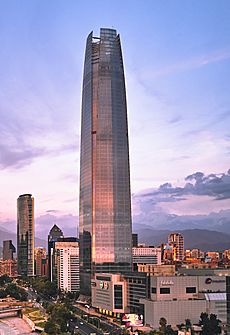
The unemployment rate in Chile was 7.8% in 2022. There are sometimes not enough workers in farming, mining, and construction. The number of Chileans living below the poverty line has dropped a lot. In 1987, 45.1% were poor. By 2009, this number was 11.5%. However, some critics say the real poverty figures are higher.
As of November 2012, about 11.1 million people (64% of the population) received help from government welfare programs. This includes people living in poverty or at risk of becoming poor. Chile has a private pension system. Most workers pay 10% of their salaries into private funds. This system has helped boost local investment.
Chile has signed many free trade agreements (FTAs) with countries around the world. For example, an FTA with the United States was signed in 2003 and started in 2004.
Mineral Resources in Chile
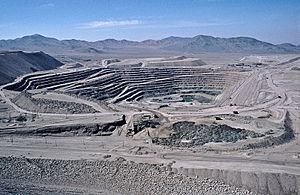
Chile is very rich in mineral resources, especially copper and lithium. Lithium is important for batteries in electric vehicles. It also helps stabilize power grids that use a lot of renewable energy. This could make Chile more important in global politics. However, some argue that other countries could also increase their lithium production.
In 2019, Chile was the world's largest producer of copper, iodine, and rhenium. It was the second largest producer of lithium and molybdenum. Chile also ranked high for silver, salt, potash, sulfur, and iron ore. The country also produces a lot of gold. Between 2006 and 2017, Chile produced between 35.9 and 51.3 tonnes of gold each year.
Farming and Fishing
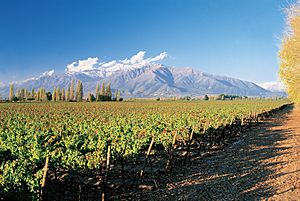
Farming in Chile includes many different activities. This is because of its unique geography, climate, and land features. Historically, agriculture has been a key part of Chile's economy. Today, farming, forestry, and fishing make up about 4.9% of the country's total economic output (GDP). They employ 13.6% of Chile's workers.
Chile is one of the top 5 world producers of cherries and blueberries. It is also one of the top 10 producers of grapes, apples, kiwis, peaches, plums, and hazelnuts. Chile focuses on exporting these valuable fruits. Other important farm products include pears, onions, wheat, maize, oats, garlic, asparagus, beans, beef, poultry, wool, fish, timber, and hemp.
Because Chile is geographically isolated and has strict customs rules, it is free from many diseases and pests. For example, it does not have mad cow disease, fruit fly, or Phylloxera. This, along with its location in the Southern Hemisphere (which means different harvesting times than the Northern Hemisphere), gives Chile an advantage in agriculture. However, Chile's mountains limit how much farming can be done. Only 2.62% of the country's land is suitable for farming. Chile currently uses 14,015 hectares of farmland.
Chile is the world's second-largest producer of salmon, after Norway. In 2019, Chile provided 26% of the global salmon supply. In wine production, Chile is usually among the top 10 countries in the world. In 2018, it was in 6th place.
Tourism in Chile

Tourism in Chile has grown steadily over the past few decades. In 2005, tourism increased by 13.6%. It brought in over 4.5 billion dollars, with 1.5 billion from foreign visitors. According to the National Service of Tourism (Sernatur), 2 million people visit Chile each year. Most visitors come from other American countries, especially Argentina. A growing number also come from the United States, Europe, Brazil, South Korea, and China.
The main attractions for tourists are beautiful natural places in the country's extreme areas. San Pedro de Atacama, in the north, is popular with foreign tourists. They come to see Inca architecture, high-altitude lakes, and the Valley of the Moon. In Putre, also in the north, you can find Chungará Lake. There are also the Parinacota and Pomerape volcanoes, which are over 6,000 meters high. In the central Andes, there are many famous ski resorts like Portillo, Valle Nevado, and Termas de Chillán.
In southern Chile, popular tourist spots include national parks. The Conguillío National Park in Araucanía is very popular. The coastal area around Tirúa and Cañete, with Mocha Island and Nahuelbuta National Park, is also visited. The Chiloé Archipelago and Patagonia are major attractions. Patagonia includes Laguna San Rafael National Park with its many glaciers, and the Torres del Paine National Park. The central port city of Valparaíso, a World Heritage Site with its unique buildings, is also popular. Finally, Easter Island in the Pacific Ocean is one of Chile's top tourist spots.
For Chileans, tourism mostly happens in the summer (December to March). They often visit coastal beach towns. Arica, Iquique, Antofagasta, La Serena, and Coquimbo are the main summer centers in the north. Pucón, on the shores of Lake Villarrica, is the main center in the south. The coast of the Valparaíso Region, with its many beach resorts, gets the most tourists because it's close to Santiago. Viña del Mar, a wealthier city near Valparaíso, is popular for its beaches, casino, and its annual song festival. This festival is the most important music event in Latin America. Pichilemu in the O'Higgins Region is known as South America's best surfing spot.
In November 2005, the government started a campaign called "Chile: All Ways Surprising." This campaign aims to promote Chile internationally for both business and tourism. Museums in Chile, like the Chilean National Museum of Fine Arts built in 1880, display works by Chilean artists.
Chile is home to the famous Patagonian Trail. This trail runs along the border between Argentina and Chile. Chile recently opened a huge scenic route for tourism. It hopes to encourage development that also protects nature. The Route of Parks covers 1,740 miles. It was designed by Tompkins Conservation.
Chilean Literature
Chileans call their country país de poetas, which means "country of poets." Gabriela Mistral was the first person from Latin America to win a Nobel Prize for Literature (in 1945). However, Chile's most famous poet is Pablo Neruda. He also received the Nobel Prize for Literature (in 1971).
Other Chilean poets include Lily Garafulic, Vicente Huidobro, Pablo Simonetti, and Paulo Coloane. Isabel Allende is the best-selling Chilean novelist. Over 51 million of her novels have been sold worldwide. Critic Harold Bloom said that novelist José Donoso's novel The ... Bird of the Night is one of the important works of 20th-century Western literature. Another internationally recognized Chilean novelist is Roberto Bolaño. His books translated into English have been very well received by critics.
Chilean Cuisine
Chilean food shows the country's varied landscape. There is a wide range of seafood, beef, fruits, and vegetables. Traditional recipes include asado (barbecue), cazuela (stew), empanadas (filled pastries), humitas (corn cakes), pastel de choclo (corn pie), pastel de papas (potato pie), curanto (seafood and meat stew), and sopaipillas (fried pastries).
Crudos is an example of how different cultures have influenced Chilean food. Onions were brought by the Spanish colonists. The use of mayonnaise and yogurt was introduced by German immigrants, as was beer.
Sports in Chile
Chile's most popular sport is association football (soccer). Chile has played in eight FIFA World Cups, and it hosted the 1962 FIFA World Cup. The national football team has reached four finals at the Copa América. They have also won one silver and two bronze medals at the Pan American Games. At the 2000 Summer Olympics, they won a bronze medal. Chile also finished third in the FIFA under-17 and under-20 youth tournaments. The top football league in Chile is the Chilean Primera División. In 2011, it was ranked as the ninth strongest national football league in the world.
Tennis is Chile's most successful sport. Its national team won the World Team Cup clay tournament twice (in 2003 and 2004). They played in the Davis Cup final against Italy in 1976. At the 2004 Summer Olympics, Chile won gold and bronze medals in men's singles. They also won gold in men's doubles. Marcelo Ríos became the first Latin American man to reach the number one spot in the ATP singles rankings in 1998. Anita Lizana won the US Open in 1937. She was the first woman from Latin America to win a Grand Slam tournament. Luis Ayala was a runner-up twice at the French Open. Both Ríos, Nicolas Massu Friedt, and Fernando González Ciuffardi reached the Australian Open men's singles finals. González also won a silver medal in singles at the 2008 Summer Olympics in Beijing.
At the Summer Olympic Games, Chile has won a total of two gold medals (in tennis). They have also won seven silver medals (in athletics, equestrian, boxing, shooting, and tennis). They have four bronze medals (in tennis, boxing, and football). In 2012, Chile won its first Paralympic Games medal, a gold in Athletics.
Rodeo is Chile's national sport. It is popular in the more rural areas of the country. Skiing and snowboarding are practiced at ski centers in the Central Andes. Surfing is popular in some coastal towns. Polo is also played professionally in Chile. In 2008, Chile won the top prize in the World Polo Championship.
Basketball is a popular sport. Chile won a bronze medal in the first men's FIBA World Championship in 1950. They won another bronze medal when Chile hosted the 1959 FIBA World Championship. Chile also hosted the first FIBA World Championship for Women in 1953, finishing with the silver medal. Other sports like marathons and ultramarathons are also becoming more popular. San Pedro de Atacama hosts the yearly "Atacama Crossing." This is a six-stage, 250-kilometer footrace with about 150 competitors from 35 countries each year. The Dakar Rally, an off-road car race, has been held in both Chile and Argentina since 2009.
National Symbols of Chile
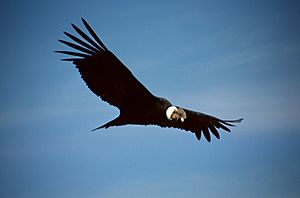
The national flower of Chile is the copihue (Lapageria rosea), also known as the Chilean bellflower. It grows in the forests of southern Chile.
The coat of arms features two national animals. These are the condor (Vultur gryphus), a very large bird that lives in the mountains, and the huemul (Hippocamelus bisulcus), an endangered white-tailed deer. The coat of arms also includes the motto Por la razón o la fuerza, which means "By reason or by force."
The flag of Chile has two equal horizontal bands. The top band is white, and the bottom band is red. There is a blue square on the left side, the same height as the white band. Inside the blue square is a white five-pointed star in the center. The star represents a guide to progress and honor. The blue color stands for the sky. The white color represents the snow-covered Andes Mountains. The red color symbolizes the blood spilled to gain independence.
Related Pages
Images for kids
-
Lautaro, toqui and hero of the Arauco war
-
Pedro de Valdivia, conqueror of Chile
-
Bernardo O'Higgins, Libertador and the Supreme Director of Chile
-
The Battle of Iquique on 21 May 1879. The victory of Chile in the War of the Pacific allowed its expansion into new territories.
-
Chile's Almirante Latorre dreadnought in 1921
-
Fighter jets bombing the Presidential Palace of La Moneda during the Chilean coup of 1973
-
Five presidents of Chile since Transition to democracy (1990–2022), celebrating the Bicentennial of Chile
-
Araucaria araucana trees in Conguillío National Park.
-
Andean condor (Vultur gryphus), the national bird of Chile.
-
Topographic map of Chile. To view maps based on SRTM topographic relief of the country, see here.
-
Osorno Volcano and the Petrohué River
-
Nef Glacier and the Plomo Lake
-
General Carrera lake, the largest in the country.
-
Mapuche women of Tirúa
-
Chilean (blue) and average Latin American (orange) GDP per capita (1980–2017)
-
Chuquicamata, the largest open pit copper mine in the world
-
Vineyard in the Casablanca Valley
-
Torre Entel in Santiago de Chile, with the Andes mountains in the background
-
Chilean asado (barbecue) and marraqueta
-
The Chilean national polo team with President Michelle Bachelet and the trophy of the 2015 World Polo Championship.
See also
 In Spanish: Chile para niños
In Spanish: Chile para niños




